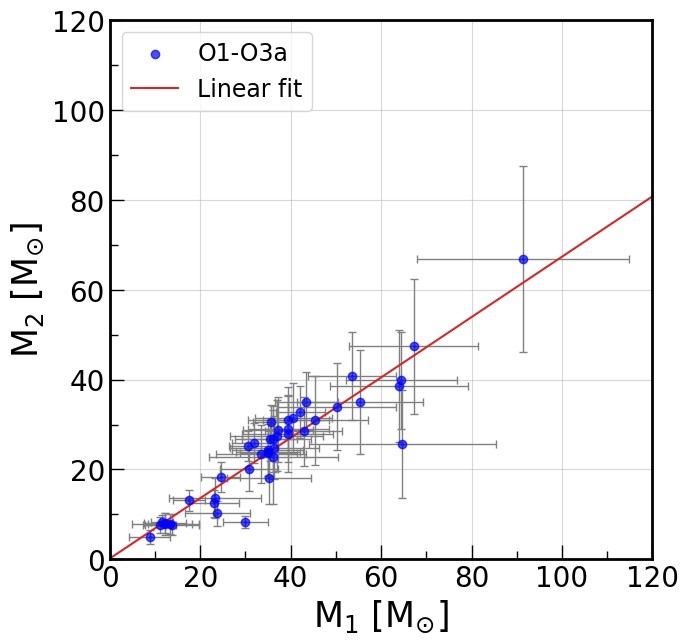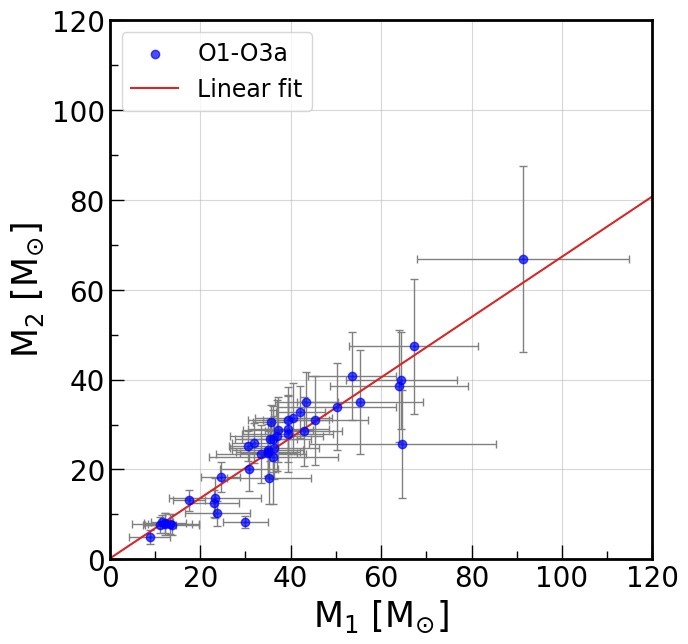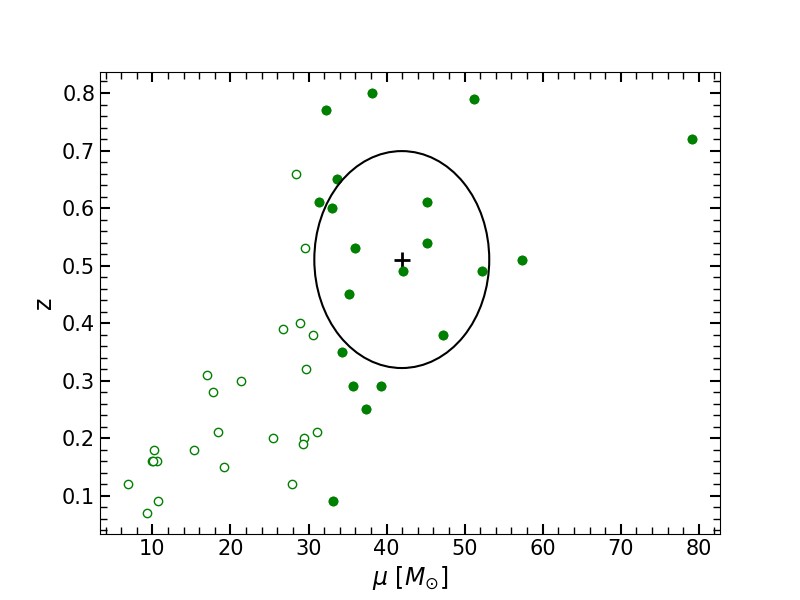GWTC-2 데이터를 이용한 쌍 블랙홀의 기원 연구
물리천문학과 Maurice van Putten
2017년 노벨 물리학상을 받은 LIGO의 쌍 블랙홀 (BBH)의 병합 사건, GW150914의 검출은 중성자별-중성자별 또는 중성자별-블랙홀의 병합와 같은 사건들로 가득 찬 우주의 새로운 창을 열었다.
LIGO-Virgo 중력파 공동연구팀은 2021년, 40개 이상의 쌍 블랙홀 병합 사건들을 포함하는 새로운 중력파 검출 카탈로그 GWTC-2를 발표 하였다. 이는 쌍 블랙홀의 질량들과 후기 우주의 적색편이 분포 간의 상대적으로 강한 연관성을 포함한 몇몇 새로운 통계적 특징들을 드러내었다 (그림1-2).

그림 1. GWTC-2의 쌍 블랙홀의 주성 (M_1)과 동반성(M_2)의 질량 분포 (파란색 점)와 불확실성 (회색 +)을 나타낸다. 선형 피팅 결과(빨간색 실선)은 0.63의 기울기와 0.93 ± 0.06의 상관계수를 보여준다.
이러한 쌍 블랙홀들은 무거운 별 탄생의 잔재로 여겨진다. 1955년, Edwin E. Salpeter는 단일 별의 초기질량 함수를 도입 하였으며, 이를 Salpeter 지수, α_S = 2.35를 가지는 멱 법칙으로 기술하였다. 이는 놀랍도록 견고한 관계로 입증되어, 현재까지도 별 형성을 이해하는 데에 중요한 역할을 해오고 있다.
ANU의 박혜진 박사과정생과 세종대의 김신정 석사후연구원, 김신나 석사후연구원과 Maurice H.P.M. van Putten 교수는 The Astrophysical Journal (천체물리학 저널)에 게재되는 논문에서, 쌍 블랙홀들의 기원이 되는 쌍성들의 평균 질량 μ의 멱 법칙 지수 (α_B^') 가 각각 최대 상관 질량, 비 상관 질량의 한계인 α_S≲α_B^'≲2α_S 를 만족해야 함을 보여준다. 이 논문에서 GWTC-2 데이터는 쌍 블랙홀 병합의 평균질량 분포의 가장자리 (μ ≳ 31태양질량)에서 α_B≃2α_S의 멱 법칙 지수를 보인다. 이는 즉, 쌍 블랙홀의 기원이 되는 기원 항성들의 질량이 비 상관임을 보여준다. 또한, 그림 1에 나타난 쌍 블랙홀 질량 간의 다소 밀접한 상관관계는, 관측된 쌍 블랙홀들을 생성하는 두 개의 초신성의 폭발이 시작되기 전에, (쌍성 시스템을 유지한 채로) 두 항성이 비슷한 질량을 가지도록 상당한 질량 전달이 이루어 지는 쌍성 진화론을 시사한다.
ΛCDM 현대우주론에서, 쌍 블랙홀들의 기원이 되는 쌍성 질량의 멱 법칙 지수 (α_B')는 우주론적 적색편이가 증가할수록 커진다. 하지만 GWTC-2의 관측에서 도출된 α_B≃2α_S 를 고려했을 때, 지수 α_B^' 는 α_B 보다 클 수 없다. 쌍 블랙홀들의 병합시간은 따라서 허블 타임 (139억년)보다 상대적으로 짧을 것이다. 즉, 기원이 되는 쌍성이 탄생했을 때의 적색편이 분포는 관측된 쌍 블랙홀들의 적색편이 분포 (그림 2)와 상대적으로 가까울 것이다. 특히, 이것은 쌍 블랙홀들의 기원이 되는 쌍성이 항성 종족 III 초기 우주 시대보다는 우주적으로 별 형성률이 절정이었던 시기 이후 (적색편이 z < 2), 즉, 상대적으로 최근인 후기 우주(최근 우주)에 태어났음을 시사한다.

그림 2. 적색편이 z와 쌍 블랙홀의 평균 질량 μ 분포 (초록색 동그라미). 질량분포의 꼬리 부분은 채워진 동그라미로 표시되어 있다. 꼬리 부분에서의 쌍 블랙홀의 평균 질량 (41.9태양질량)과 적색편이의 평균값 (0.51)을 1 평균 편차 (타원)과 함께 + 표시로 나타내었다.
2023년 3월에 계획된 LIGO-Virgo-KAGRA의 O4-5 관측은 더 확장된 쌍 블랙홀 병합의 관측 데이터를 제공함으로써 우리의 결론을 확고히 할 수 있을 것이다. 이러한 앞으로의 관측은 쌍 중성자별 병합과 그들의 병합 후 진화, 그리고 나아가 긴 감마선 폭발(long GRB)과 관련된 강력한 중심붕괴(core-collapse) 초신성 폭발을 포함한 지역우주(즉 가까운 우주)의 관측 자료를 제공할 것이다.
추가 읽기 자료
GWTC-2 카탈로그: https://www.ligo.org/science/Publication-O3aCatalog/index.php
Hye-Jin Park, Shin-Jeong Kim, Shinna Kim & Maurice H.P.M. van Putten, 2022, ApJ, https://doi.org/10.3847/1538-4357/ac9300, 938, 69
ON THE PROGENITORS OF BBHs IN GWTC-2
The seminal LIGO detection of the binary black hole (BBH) merger event GW150914 - awarded the Nobel Prize of Physics in 2017 - opened a new window to the Universe, rife with similar events including mergers of neutron stars with another neutron star or black hole.
The updated gravitational-wave detection catalogue GWTC-2 of 2021 released by the gravitational-wave collaboration LIGO-Virgo contains more than 40 BBH mergers events revealing some novel statistical properties such as a relatively tight correlation between their binary masses and a redshift distribution in the late-time Universe (Figs. 1-2).

Figure 1. Overview of primary (M1) and secondary (M2) masses of BBHs in GWTC- 2. Grey crosses indicate uncertainties. A linear fit shows a slope 0.67 with a correlation coefficient r = 0.93 ± 0.06.
These BBHs are believed to be remnants of massive star-formation. In 1955, Edwin E. Salpeter introduced the Initial Mass Function (IMF) of single stars, described by a power law with Saltpeter index of α_S=2.35. This relation has proven to be remarkably robust and continues to be a central theme in understanding star formation.
In a paper to appear in The Astrophysical Journal, PhD candidate Hye-Jin Park of ANU, recent graduates Shin-Jeong Kim, Shinna Kim and Professor Maurice H.P.M. van Putten of Sejong University show that the power law index of the mean mass μ of binary stellar progenitors of BBHs satisfies α_S≲α_B^'≲2α_S in the limit of maximally correlated, respectively, uncorrelated masses. GWTC-2 shows a power law index of α_B ≃2α_S in the tail of μ ≳ 31M☉ the BBH mergers, indicating uncorrelated progenitor stellar masses. The rather tight correlation of BBH masses shown in Fig. 1 suggests a binary stellar evolution with considerable mass-transfer to relatively similar masses, before the onset of two supernovae producing the observed BBHs (without disrupting the binaries).
On a ΛCDM cosmology, the power law index α_B' of the progenitor stellar binary systems increases with cosmological redshift. Yet, the observed relation α_B≃2α_S effectively prohibits α_B'>α_B. The merger time of BBHs is hereby limited to time-scales relatively short compared to a Hubble time, i.e., the redshift distribution of their stellar progenitors is relatively close to that of the BBH mergers observed (Fig. 2). This puts BBH progenitors in late-time cosmology, at relatively recent times past the peak in the cosmic star-formation rate (i.e., z < 2), rather than the early epoch of Pop III stars.

Figure 2. Redshifts (circles) versus mean mass μ of the BBH with elements in the tail highlighted (filled). Mean values of mean mass and redshift in the tail (+) is indicated with 1σ uncertainty (ellipse).
Upcoming LIGO-Virgo-KAGRA observational runs O4-5 planned for March 2023 may solidify our conclusions with an enlarged data-base of BBH mergers. These upcoming observations may provide a survey of the Local Universe including double neutron star mergers and their post-merger evolution, perhaps including energetic core-collapse supernovae associated with long gamma-ray bursts.
Additional Reading
GWTC-2 catalog: https://www.ligo.org/science/Publication-O3aCatalog/index.php
Hye-Jin Park, Shin-Jeong Kim, Shinna Kim & Maurice H.P.M. van Putten, 2022, ApJ, 938, 69, https://doi.org/10.3847/1538-4357/ac9300